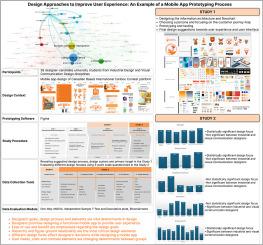改善用户体验的设计方法:以手机应用原型设计过程为例
IF 5.1
2区 计算机科学
Q1 COMPUTER SCIENCE, CYBERNETICS
International Journal of Human-Computer Studies
Pub Date : 2025-06-08
DOI:10.1016/j.ijhcs.2025.103569
引用次数: 0
摘要
近年来,用户体验、用户-产品交互和数字产品已经成为设计学科中日益流行的话题。本研究旨在揭示设计师候选人在设计驯鹿大赛移动应用程序过程中的方法和产品决策。本研究包括38名来自不同设计学科的学生的设计过程,包括工业设计和视觉传达设计。研究1说明了设计人员通过从研究到原型阶段的过程管理提出的设计示例。研究2的目的是确定设计师优先考虑哪些研究课题,他们对产品的目标,他们的可用性考虑,以及他们对用户和关键设计元素的关注。两种不同设计学科的共同观点和不同的批判性评价也被揭示出来。评估通过5分制问卷收集,并使用JASP软件进行分析。可以确定的是,设计师非常重视原型设计阶段,他们使用Figma程序进行了原型设计。关于设计目标,易用性和效益的概念被强调。对设计元素之间的层次关系和图地关系的强调是值得注意的。这两个学科对用户需求的重要性不同,颜色和对比设计元素的选择也不同。通过设计师在用户体验和用户界面方面的决策确定的基本品质为未来以用户为中心的产品设计提供了理论见解。所获得的信息也可以通过原型和视觉屏幕来解释,这些原型和视觉屏幕实际上可以支持类似的研究结果。本文章由计算机程序翻译,如有差异,请以英文原文为准。

Design approaches to improve user experience: An example of a mobile app prototyping process
User experience, user-product interaction, and digital products have become increasingly popular topics within design disciplines in recent years. This study aims to reveal the approaches and product decisions of the designer candidates during the design of the Caribou Contest mobile application. This study includes the design process of 38 students from different design disciplines, including Industrial Design and Visual Communication Design. Study 1 illustrates the design examples suggested by the designers through their process management from the research to the prototyping stage. Study 2 aims to determine which research topics the designers prioritised, their goals over the product, their usability considerations, and their focus on the user and the critical design elements. The shared perspectives and different critical evaluations of two different design disciplines are also revealed. The evaluations are collected via a 5-point scale questionnaire and analysed with JASP software. It is determined that the designers gave great importance to the prototyping stage, which they carried out using the Figma program. The concepts of ease of use and benefit are emphasised regarding the design goals. The emphasis on hierarchy and figure-ground relationships among the design elements is remarkable. The two disciplines differ in their importance to user needs and choice of colour and contrast design elements. The fundamental qualities identified through the designers’ decisions in terms of user experience and user interface perspectives provide theoretical insights for future user-centred product designs. The obtained information is also explained through prototypes and visual screens that can practically support similar study outputs.
求助全文
通过发布文献求助,成功后即可免费获取论文全文。
去求助
来源期刊

International Journal of Human-Computer Studies
工程技术-计算机:控制论
CiteScore
11.50
自引率
5.60%
发文量
108
审稿时长
3 months
期刊介绍:
The International Journal of Human-Computer Studies publishes original research over the whole spectrum of work relevant to the theory and practice of innovative interactive systems. The journal is inherently interdisciplinary, covering research in computing, artificial intelligence, psychology, linguistics, communication, design, engineering, and social organization, which is relevant to the design, analysis, evaluation and application of innovative interactive systems. Papers at the boundaries of these disciplines are especially welcome, as it is our view that interdisciplinary approaches are needed for producing theoretical insights in this complex area and for effective deployment of innovative technologies in concrete user communities.
Research areas relevant to the journal include, but are not limited to:
• Innovative interaction techniques
• Multimodal interaction
• Speech interaction
• Graphic interaction
• Natural language interaction
• Interaction in mobile and embedded systems
• Interface design and evaluation methodologies
• Design and evaluation of innovative interactive systems
• User interface prototyping and management systems
• Ubiquitous computing
• Wearable computers
• Pervasive computing
• Affective computing
• Empirical studies of user behaviour
• Empirical studies of programming and software engineering
• Computer supported cooperative work
• Computer mediated communication
• Virtual reality
• Mixed and augmented Reality
• Intelligent user interfaces
• Presence
...
 求助内容:
求助内容: 应助结果提醒方式:
应助结果提醒方式:


